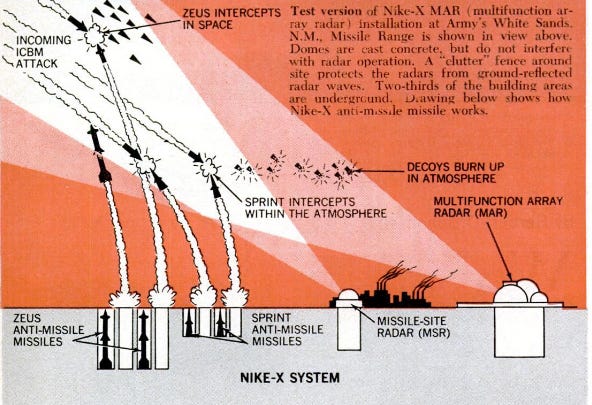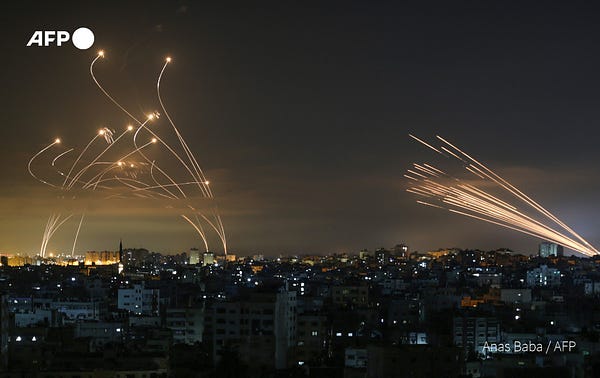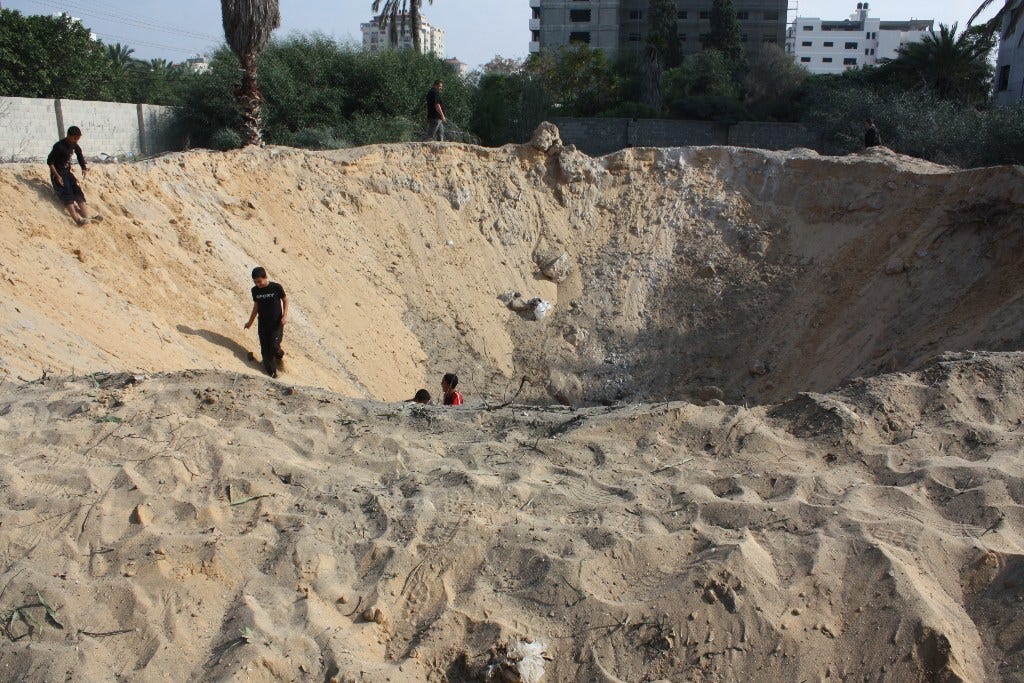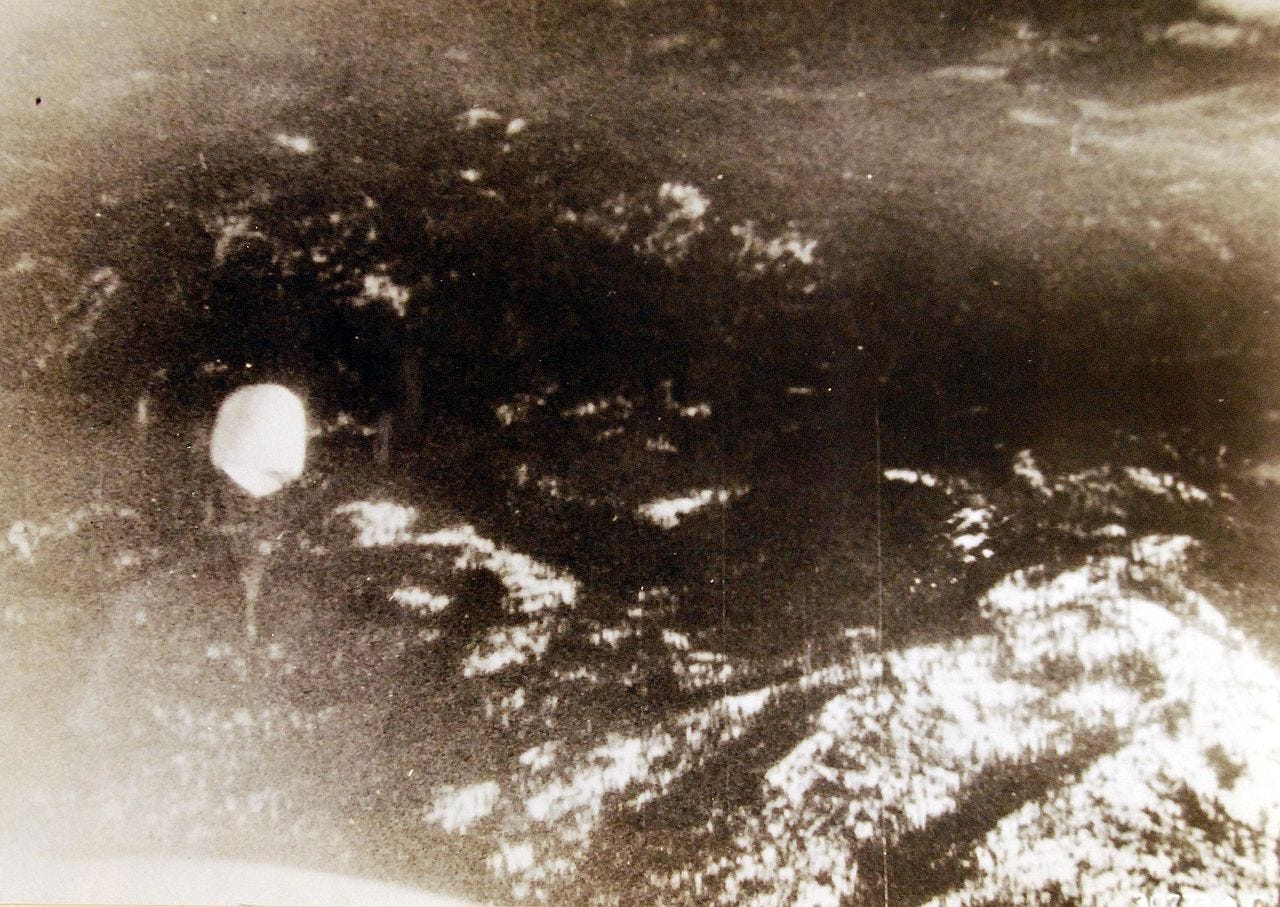Incendiary Balloons, Iron Domiciles
Asymmetric warfare, illusions of security, and what an incendiary in the Pacific Northwest has to do with the politics of missile defense.
I first learned about incendiary balloons in Albuquerque, at the International Balloon Museum. There, the story focused on the Fu-Go balloon attack, hydrogen balloons launched into the jet stream in 1944 and 1945. Over the course of its flight, it would rise in the day and then sink in the night, as heating expanded the gas inside. With an altimeter-controlled ballast system, the balloons would cut weight when they dropped too low at night, and vent gas when they got too high during the day.
As a piece of technology, it was a remarkable feat: balloons launched from Japan, carried by high-altitude winds, could automatically crash into the forests and cities of the United States, sparking fires. National Geographic describes it as “the first intercontinental weapon system,” and it is technically true. It was a weapon that could cause harm on a different continent.
There are six deaths recorded in the continental US from the balloons, five children and 26-year-old Elsie Mitchell, who was five months pregnant at the time. The family came across a balloon they’d found in the woods of Oregon, which exploded as they encountered it. It’s a tragedy, as civilian deaths in war especially are, but what’s remarkable is how their deaths were the only tragedy from the attack.
Over 9,000 of the balloons were launched into the jet stream and at the United States. Those that landed did so, overwhelmingly, in the Pacific Northwest, in the rainy season of one of the wettest years recorded. In “A Fire Management Perspective of FuGo”, published in the January 2017 issue of Fire Management Today, author Jameson Karns describes how the threat of the balloons, more than their reality, transformed the federal government’s approach to fighting fires, elevating them to a matter of war-like importance and with a similarly all-encompassing response.
What stands out about the incendiary balloons is not just their range but the extremely limited ability to cause harm. It’s a marked contrast from the weapons held across Albuquerque, in the National Museum of Nuclear Heritage and History. I had intended to frame this as a sort of symbolic parallel, but reading Karns, I found a direct connection between the incendiary balloons and atomic weaponry.
“Yet the most tactically successful bombing would remain classified for decades,” Karns writes.
“On March 10, 1945, a balloon bomb damaged the power generators of the Hanford Engineering Works production facility in Washington...Unknown to the Japanese and the American public, Hanford Engineering was one of the most important facilities of the American war effort because it housed a top-secret reactor that was responsible for supplying plutonium to the Manhattan Project. Less than half a year after this event, plutonium from Hanford was deployed in an atomic bomb over the city of Nagasaki.”
To the best of my memory, the FuGo exhibit at the balloon museum names the specific victims of the incendiary bomb. At the Nuclear Museum, the devastation of the US-dropped bombs is conveyed entirely in still images of rubble and artifacts, with no names or human remains to match the devastation.
By its own estimation, the United States bombing of Hiroshima and Nagasaki killed at least 110,000 people.1
I
I have been trying to write this story for at least a month.
Astute readers of Discontents Blog may remember that I talked up a coming story about Iron Dome and the limitations of setting policy by weapon in the May 24 newsletter.
There’s a lot to say about how specific weapons can shape war and policy, about how this specific weapon could shape war or policy, and I’ll get to it, but what I want to talk about first is how the perception of danger can be wholly divorced from the scale of danger.
And to do that, I’m going to talk about incendiary balloons again, from an attack just last week.
“The incendiary balloons sparked 20 fires in southern Israel on Tuesday [June 15, 2021]” reports the BBC, noting quickly that there were no casualties reported from either the incendiary balloons or Israel’s air strikes on Gaza that followed.
There’s a host of reasons for incendiary balloons to be more effective in 2021 Israel than they were against 1945 United States. An incomplete list: orders of magnitude shorter flight times, no need to rely on the jet stream, decades of trends towards a drier climate, an already arid (and thuse target-rich) region.
That’s not really the point, though. The scale of harm from deliberately maliciously launched incendiary balloons strikes me as almost certainly smaller than the hazard posed, stateside, by annual firework-sparked wildfires. This is a hazard that a society can, if it so chooses, treat as a sort of ambient harm and manage through active firefighting.
People in countries can respond to attacks in a host of ways, and will often take cues from political leaders about how seriously to treat a threat. With the FuGo balloons, the United States actively suppressed some information, as part of a deliberate strategy to not induce panic in the public.
Granted, that’s a harder approach in communications-rich 2021 than it was in 1945, but it’s still a choice made by a government over how to address a novel and known threat.
Israel’s new Bennett administration, days old, instead decided to respond to balloons and fire with jets and bombs. It’s a choice available to the heads of state, indeed one of the central tool kits nations build towards, but it is hard to imagine how thousands of dollars worth of bombs dropped from millions of dollars worth of jet are an effective response to a weapon that can be assembled from party supplies and fireworks.

II
There is, to the best of my knowledge, no specific counter-balloon weapon. As flying machines go, balloons are the simplest, the hardest to direct, and the most ponderous. Managing balloon-delivered weapons is about putting out the fires they set, and about disabling the incendiaries and explosives that land without detonation.
It is all aftermath, and almost always extremely manageable aftermath.
This makes it, I think, a useful mirror to the entire field of missile defense, which is all about averting disaster before there’s an aftermath at all. Iron Dome is a kind of missile defense, though it operates on a much different scale in every respect than the nuclear escalation that marked missile defense at its start.
This history of missile defense is about trying to engineer a specific solution to a particular kind of fast-moving armageddon. (Here I’m leaning heavily on the Union of Concerned Scientists timeline of US missile defense, and also the Carnegie Endowment’s brief history of it). Missile defense took form in the aftermath of two novel weapons, before they had been fused: there were German V-2 Rockets (a kind of continental weapon), and nuclear warheads. To stop a nuclear missile, the US explored shooting another missile at it, or at least near it.
The Nike-X was a nuclear-tipped interceptor that solved one problem with another. Missile defense proponents often describe the act as “shooting a bullet with a bullet,” and while that’s the approach behind a lot of modern interceptors, the Nike skipped right around that. Interception is hard, so instead of colliding with another missile, the Nike would just detonate near it, creating a distant explosion (possible high atmosphere, or maybe even space). It’s less hitting a bullet with a bullet, more hitting a bullet with a hand-grenade. Or a nuke.2
The system was dismantled mere months after being stood up in North Dakota, and arms control treaties limited the continued development by both the United States and the Soviet Union. When the United States returned to working on interceptors, it would do so without the nukes at the tips, which took a bad calculus and made it much, much worse.
There exists a fundamental flaw at the heart of any missile defense system, and especially at the heart of any missile defense built to stop nuclear weapons: it’s cheaper to attack than to stop an attack. This can be accomplished through more missiles, more warheads, by deploying decoys and chaff, by launching massive barrages. Even if interceptors can stop some of the missiles, some of the time (a thing they at present emphatically cannot do,) the interceptors have to get lucky every time, and the nukes only need to get lucky once.
Research on missile defense continued well past the end of nuclear tipped interceptors in 1978. Spurred by Reagan, who was sold on the idea of modern technology winning a nuclear war, the United States has continued to invest in high- and low- end missile defense since 1983.3 Yet what changed the nuclear risk wasn’t any of these systems, which have a deeply mediocre record in test conditions, but arms control reduction treaties. Missile defense encourages arms races; diplomacy, over decades, dismantled thousands of missiles peacefully.4
There is a politics to building, deploying, and using defense weapons, and like all politics by technological means, it is a politics that other actors can respond to.

III
Iron Dome is an interception system. It consists of a bevy of sensors, launchers that fire the interceptors, and humans that manage the whole apparatus. As of 2014, each anti-rocket missile battery cost between $50 and $80 million and each interceptor fired costs $40-50,000. It is specifically deployed to stop rockets, of the kind deployed by organized non-state actors.
The Qassam rockets date back to at least 2002, and are a weapon of asymmetric warfare. They were cheap to produce back in 2008, costing around $800 apiece then. With stabilizer fins and a dead-simple construction, the rockets arc in a simple trajectory. That has two durable effects. The first is that, while this is a weapon that can be pointed in a direction, it cannot be aimed at anything specific within it, really. The simple rocket is faster than an incendiary balloon, and it flies a more straightforward path, but it’s just as much aimed at an area and released.
Secondly, the limited trajectory and inability to steer inflight means that, if the rockets can be detected in time after launch, it should be easy to intercept them. Or at least, much easier than a rocket that can adjust flight path at all. And while in-flight navigation may have once been cost-prohibitive disposable weapons assembled from simple parts, the ever-lower costs of hobbyists drone parts mean it likely won’t be hard to engineer newer rockets that can evade more interceptors.
My original draft of this story, written way back in mid-May, spent lots of time talking about one specific picture of Iron Dome in action.
It’s this one:


From that draft:
The picture is striking, almost cosmic in its detachment. On the left of the frame, missiles launch and circle, bright against the night sky. To the right, an incoming barrage of rockets streak forward. Shot by Anas Baba for Agence France-Presse, the war even observes the rule of thirds. The middle of the frame is empty, save for the city below.
It is, as comments across the internet noted, cinematic, the kind of violence that marks the high-end spectacle of a PG-13 film. There are homes in the shot, but not people. Here is a kind of war story a nation likes to tell: with great foresight and technological prowess, a military averts tragedy.
What I want to add to all this is that it's entirely possible this is close to the last time we see the contrast between Iron Dome and the rockets it was built to intercept so cleanly. The swirling interceptors, fed sensor data and adjusting trajectory, will this time intercept most but not all of the rockets launched their way. Eventually, those rockets may be more numerous and more agile, enough to convert a small margin of error into a crisis.
Telling the story of the weapon is not complete without describing the politics in which it is put to use.

IIII
Iron Dome is a state-level tool used in this specific instance to anticipate and mitigate harm from a specific, predictable kind of attack. Developing, maintaining, and expanding Iron Dome is, like all military spending decisions, subject to a variety of influences but central among them must be a belief that it is and will remain useful against an attack that is likely to come in the future, many times.
When the government of Israel announced in April that it would forcibly remove eight Palestinian families from their homes in the Sheikh Jarrah neighborhood of Jerusalem, it was not inevitable that rocket attacks would follow. Yet it was eminently predictable, and having Iron Dome in place affords the government of Israel some freedom to act despite those predictions. This action can include a range of behaviors, from refusing to police violence by settlers against Palestinians, to launching airstrikes against buildings in Gaza under the pretext that militants used those same high-rises to launch rockets.
“Iron Dome removes most of the probability of dying in what would otherwise be a serious bombardment, but not enough to remove the feeling of threat,” Simon Frankel Pratt, a friend and poli-sci professor, told me, as I hashed this out on Twitter. “Major disparity between [Tel Aviv] (fireworks) and places closer to Gaza. This accentuates the performativity of Hamas/[Palestinian Islamic Jihad] rockets… Yet Hamas successfully killed Israelis in the centre. This is a really big deal actually but think about if [Iron Dome weren't there. [Iron Dome] maintains the status quo even as Hamas's rocket capabilities grow considerably. Crystallizes a strategic arrangement more than it changes it.”
I think “Crystallizes a strategic arrangement more than it changes it” is exactly right, and what especially stands out is that Iron Dome doesn’t have to be used this way. It is possible to imagine a different government of Israel, with different priorities, developing or inheriting a missile defense system and using the degree of partial safety it provides to pursue a strategy built on defusing the conflict through concessions and peace work, even in the face of rocket onslaught. This is not what happened.
Paired with retaliatory airstrikes, Iron Dome exacerbates a balance of violence in favor of the well-equipped state. Iron Dome cannot be separate, at this point, from Israel’s 15 year blockade of Gaza by land and sea. This blockade failed to prevent militants from building and launching rockets, but it did cause a tremendous degree of human suffering, in the name of weaking the military power of an armed group that operates within it.
It also, for a long time, kept Netanyahu in power, a hardliner eager and ready to do violence. That Iron Dome has been, in this, paired with airstrikes and artillery and other forms of retaliation demands that we look at the weapon as part of this greater whole, and not a form of defense separate from the broader picture.
“Hamas/[Palestinian Islamic Jihad] realistically are unlikely to be able to fire more rockets next time, though they might be able to fire more at the centre. Israel did not run out of interceptors. This dynamic will not escalate out of the current strategic arrangement,” Pratt continues. “However, Hamas has shown that it can interpose itself into whatever is happening in the [West Bank] and in Israel, score symbolic victories and oblige Israel to engage in emergency measures. This is continuity but not in any good direction and still enough to 'spoil' negotiations if it wanted.”
That the post-Netanyahu government of Israel has already responded to balloon attacks with airstrikes, to say nothing of continuing violence against civilians, suggests that the durable politics built around Iron Dome will remain in place.
Likely outcomes are not inevitable outcomes, and in writing about how weapons shape policy and policy shapes weapons, I think it’s of supreme importance to make that delineation. It matters, especially, for the civilians whose lives are held at risk not just by weapons launched at them, but by the promises of safety that defenses cannot guarantee.
Nuclear missile defense is fundamentally a destabilizing technology. If Iron Dome holds in place a politically untenable status quo, then it provides an illusion of stability and security, while doing little to allow the government using it to try and reach a different, more durable political outcome, one that can only come from accepting the rights of others to exist.
No one is actually protected by the illusion of safety.
Greetings, Wars of Future Past readers! My name is Althea Atherton, but most of my friends call me Alymay. While you may not be familiar with my work (yet), I have been silently contributing to Wars of Future Past since its launch as the ghost-editor, Kelsey’s in-home sounding board, and a consistent “you need to explain this jargon a little better for the readers who aren’t total defense industry wonks” feedback-giver. Kelsey and I have thought over the past year that we’d like to formalize my quiet contributions to his work by officially making me his business partner and our company’s Editor-In-Chief. I’ll be working on some projects related to health communication that I have had stewing for a while and tracking all the copy-editing, transcribing, administrative help, and other miscellaneous, otherwise unrecognized and unspoken labor spouses of freelance journalists do regularly, especially on self-published works. If you would like to reach out to me about any editorial concerns, feel free to write to me at athertongazetteer@gmail.com.
Althea May Atherton
Editor-In-Chief, Atherton Gazetteer
Thank you all for reading this. I genuinely enjoy writing these newsletters every fortnight, and I will keep writing them in some form for as long as I can sustain myself doing so.
If you’re in the mood for more free newsletters, may I recommend checking out what we’re doing over at Discontents? A couple weeks ago I wrote about the Albuquerque Dongcopter.
Alex Wellerstein, an essential read on all things nuclear history, had an article published by the Bulletin of Atomic Scientists in August 2020 about the specific authorship of the accepted High and Low estimates of deaths in the atomic bombings. I’m using the low estimate here not because I necessarily think it’s more accurate, but because I think it’s worth looking at the scale of tragedy as at least as bad as that estimate, and quite possibly much worse.
Exoatmospheric nuclear detonations are the kind of event most likely to result in an EMP. It’s a real thing, it’s part of the reason this style of missile defense is bad, and it is overwhelmingly likely the kind of effect that would happen as part of a broader nuclear barrage, so it’s weird to think about it separately.
Patriot missile interceptors, once touted by the US as a technological marvel, are notorious for failing at missile interception, a failure that in part led Israel to develop its own missile defense system.
The Union of Concerned Scientists’ timeline of missile defense notes that, in October 1986, “President Reagan and Soviet President Gorbachev discuss the complete elimination of nuclear weapons, but the proposal collapses when Reagan refuses to agree to limitations on [Strategic Defense Initiative, his missile defense program].” The Nuclear Threat Initiative read of the summit similarly holds a loose US interpretation of existing missile defense treaties as a sticking point that prevented greater reductions in arsenals.





